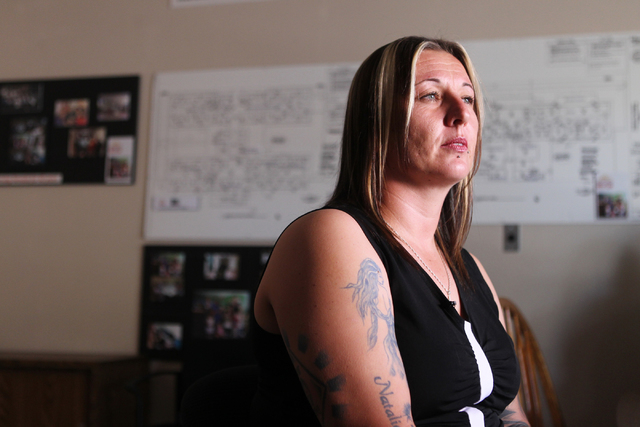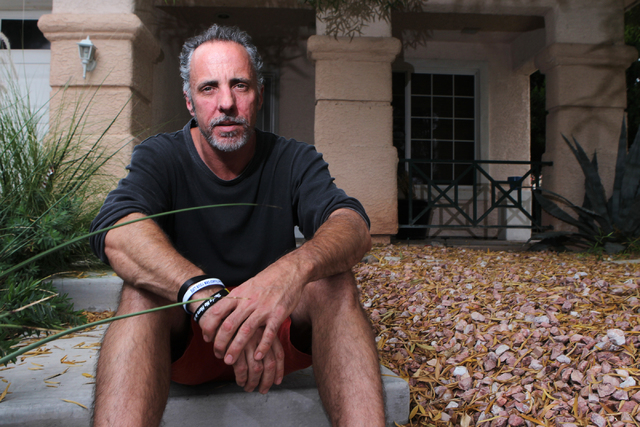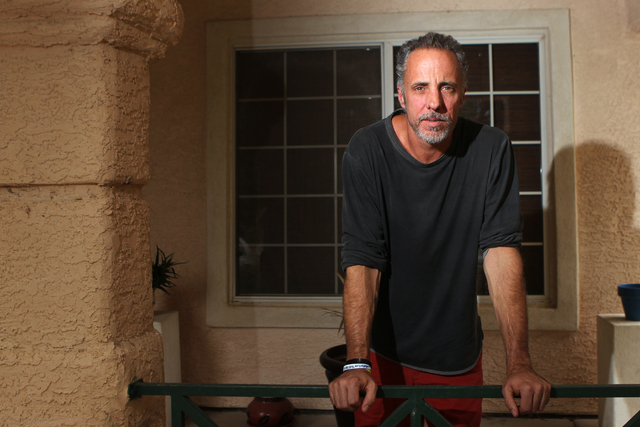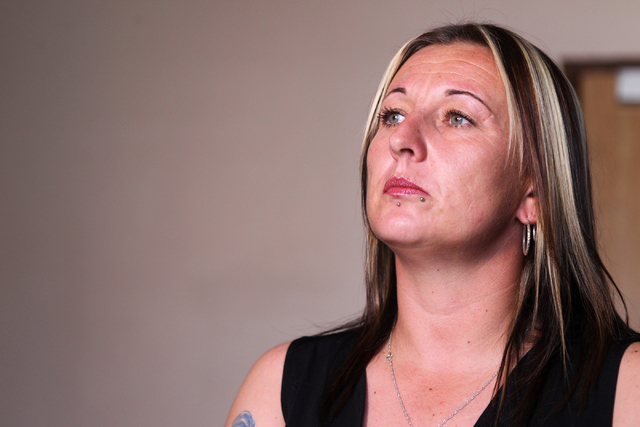Filling a void: Battling drug addiction in Sin City
The Strip lures people in with its lights, exclusive clubs and extravagant shows, but underneath its beauty lies a darker world. It is a world known as Sin City, where addictions can run wild. Narcotics are plentiful in that atmosphere.
For many drug users, it starts with innocent curiosity, but in this 24-hour town known for its easy access to the excess, curiosity can lead to a lifetime struggle.
Nevada is the fourth-leading state for drug overdose mortality rates, with 20.7 per 100,000 people suffering drug overdose fatalities, according to a 2013 report by Trust for America’s Health, a Washington, D.C.-based health policy organization.
The number of drug overdose deaths — a majority of which are from prescription drugs — in Nevada increased by 80 percent since 1999, when the rate was 11.5 per 100,000, the report stated.
“Addiction and alcoholism is in any neighborhood, everywhere and anywhere,” said Heather Frost, director of the Women & Children’s Campus at WestCare, a nonprofit that includes services from substance abuse to homeless and runaway shelters, domestic violence, treatment and prevention and mental health programs.
ADDICTION DESTROYS FAMILIES
Almost four years ago, Henderson resident Joe Engle came home to a hot house in the middle of July. He saw his son’s car in the driveway. It was around 1:30 p.m. when he noticed his dogs’ empty water bowls. He knew something was wrong.
After seven months of being clean, Joe’s oldest son, Reese, had died from a heroin overdose.
“It doesn’t matter where you live; addiction doesn’t discriminate, and it seems like it’s being more and more marketed towards suburbia,” Joe said. “If I had a chance to do it all over again, I would lock my son in the room, and I wouldn’t let him leave.”
Stimulants, including methamphetamines, are most commonly cited among primary drug treatment admissions in Nevada, according to the Nevada Control Update 2010 report.
Joe describes his son as an intense young man who was high on testosterone.
“He had a lot of girlfriends at a young age and was always on the move,” Joe said.
When Reese was in junior high school, things started to change. Little did Joe know that Reese and his younger brother Dylan began experimenting with painkillers.
“I’ve been drinking and smoking weed since I was 13,” Dylan said. “It was a natural progression for me to move along to something heavier like painkillers, but toward the end of my addiction, it became really expensive.”
Things quickly progressed.
Soon, there were constant fights inside the household. Joe’s sons had run-ins with the law, and money was always an issue.
Despite his son’s erratic behavior and trouble at school, Joe said he missed the initial signs that Reese had a problem.
“I may have dismissed it as puberty or written it off as stress,” Joe said. “I remember I had taken him to a halfway house, and he was 18 years old. He had his hoodie on, and his face was sunken, and he was pale. I remember distinctly asking myself, ‘How did my son turn into a junkie right in front of my eyes?’ ”
Despite knowing that his older brother died from a heroin overdose, Dylan switched to heroin because it was cheaper, and he enjoyed the “energy and enthusiasm” it created.
“I was so heavily addicted that my brother’s death didn’t faze me,” Dylan said. “I didn’t believe it could happen to me. Heroin took away all my worries and all of the fear that I had. It made me feel like the confident and outgoing person that I wanted to be. It was a euphoria.”
After Reese’s death, Joe started the There is No Hero in Heroin Las Vegas chapter to raise the curtain on the epidemic of heroin addiction. The nonprofit educates youths on the danger of drug use and provides scholarships for youths to get into sober living.
“There’s nobody who suffers more than the parent of a drug addict,” Joe said. “To watch somebody that you raised and sat up with when he was 4 years old and he had an asthma attack, and you spent the night in the hospital with him, and you sat there and patted his back all night long, and he looked up at you like you were his hero, and you couldn’t do anything wrong with him. To know that I don’t have any defense, that I cannot fix what’s wrong with him — that’s harder than anything that I had to go through myself.”
LAS VEGAS UNDERGROUND
Australia native and president of WestCare Alumni Nevada Barbara Starzynski said she began experimenting with drugs when she was 8 and stole cigarettes. At 13, she tried marijuana and ecstasy.
Almost 20 years later, Starzynski moved to Las Vegas because she craved adventure.
“In the beginning, it was difficult. I was without family and friends. I didn’t know this city, and in all honesty, the city is very challenging. The good and the bad of Las Vegas swept me up,” Starzynski said. “I was into a lot of different things — the party scene, the gang scene and the drug scene. That’s kind of where my addiction really took off.”
In 2008, after trying cocaine, she was introduced to methamphetamine through a club promoter at a nightclub.
That initial taste, which Starzynski describes as “an instant euphoria and a numbing feeling,” turned into a $200-a-day drug habit.
“Methamphetamine is a poison. It consumes you from the inside out,” Starzynski said. “It swallowed me as an individual. It swallowed my soul. It destroyed me internally and made me into a criminal at times.”
Soon, her family stopped talking to her, and her physical appearance became depleted. At her lowest, she weighed 112 pounds. Her skin was colored with what she describes as “a gray kind of tinge,” and she did not eat or sleep for days at a time.
After giving birth to her daughter, Child Protective Services took her away.
“I wasn’t only addicted to drugs and alcohol, but I was addicted to the street life and the hustle and the game and the fast pace of Las Vegas,” Starzynski said. “As an addict, I used it to cover my feelings. It numbed me from depression and isolation.”
THE JOURNEY TOWARD RECOVERY
Dylan may have been one of the lucky ones.
Just last month, he said his 21-year-old friend died from a heroin overdose.
With support from family and willpower, Dylan went clean on May 24, 2012.
“Before I got clean, I spent a month and a half working and staying at my uncle’s house only to pick up heroin after work and go to my room and sit there alone,” Dylan said. “It was the most detached I’ve felt. It was that inner darkness that I felt sitting in that room that made me want to change.”
He soon moved into sober living and kept himself occupied.
It was then that he was able to grieve for his dead brother and escape the grip of his addiction.
“If parents think there’s a problem with their children using drugs or alcohol, then there probably is,” Joe said. “Take action, and don’t give up hope. While they’re breathing, there’s still hope.”
While Joe may question his sons’ paths in life, Dylan said that his drug dependency formed because of a void he felt he needed to fill.
“I came from a great family that raised me well and provided me with everything,” Dylan said. “There was no reason for me to become a drug addict. There was nothing my mom or dad could have done differently. It was just something inside my mind that felt off. I dealt with that my whole life until I found drugs and alcohol to fix that insecurity.”
Starzynski had her breaking point from methamphetamine after visiting her 6-week-old daughter at Child Haven.
“I picked her up from the foster mom, and she wouldn’t look at me, and she was having an anxiety attack,” Starzynski said. “She didn’t know who I was, and she didn’t recognize me as the familiar, safe person that I was supposed to be for her. I wanted to do anything not to have that happen again.”
Once at the Women & Children’s Campus at WestCare in the northwest valley, Starzynski learned that she was an addict —something with which she never associated herself.
“I was doing drugs; I never thought I had a problem,” she said.
She soon began receiving treatment.
“You never really overcome addiction. It’s a lifelong process,” Starzynski said. “An addiction is something greater than me. I’m that person where one drink isn’t enough, and one drug isn’t enough. It’s beyond me as an individual, and it’s something that has a hold on me that I have to be aware of.”
Frost said the key to success is honesty, willingness, openness and the ability to be extremely vulnerable. Alyson Martinez, deputy director at the Women & Children’s Campus at WestCare, added that the client has to want to change first and foremost.
Martinez said that, recently, WestCare officials saw a heroin wave, but last year, synthetics such as bath salts and synthetic marijuana were popular. Methamphetamine, prescription drugs and heroin are constantly an issue, she added.
“A person in recovery is never recovered,” Frost said. “That doesn’t mean they’re struggling their whole life. It just means they have a healthy respect for the disease they have. It takes sometimes going through the gates of hell to rise up into heaven.”
To reach North View reporter Sandy Lopez, email slopez@viewnews.com or call 702-383-4686. Find her on Twitter: @JournalismSandy.
Addiction series
View plans to spend the next several months exploring the topic of addictions in Sin City in a bi-monthly series that will cover everything from alcohol and food to technology and shopping.
Watch for the next Addiction Series story in the July 23 issue, with a look at how a local nonprofit is offering help for those battling gambling addiction.

























